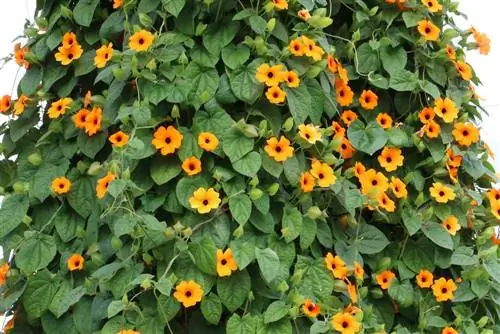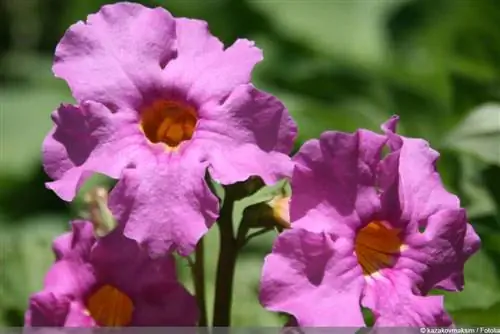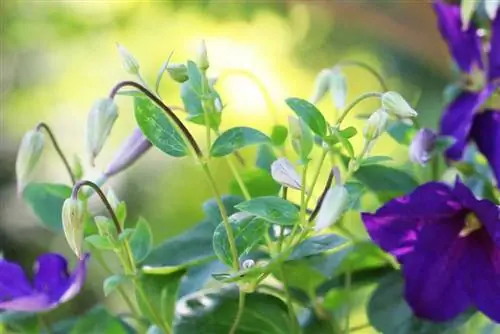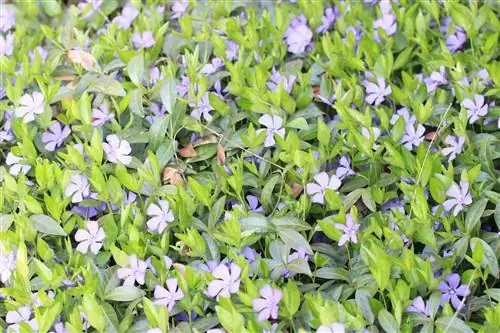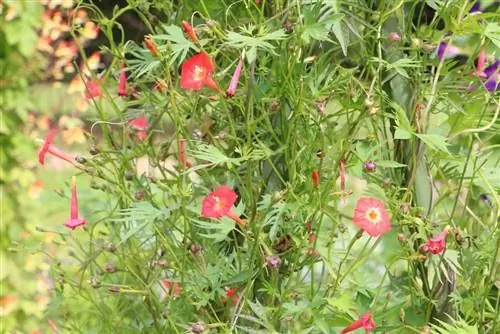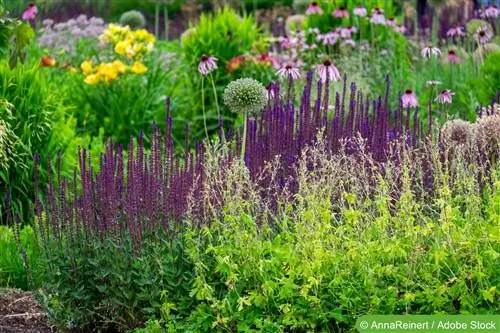- Author admin [email protected].
- Public 2023-12-17 03:39.
- Last modified 2025-01-24 12:45.
They are green. They are colourful. Some are edible. Above all: they grow incredibly quickly. Throw a few seeds in the ground, water and trust the sun. In an instant, a curtain of plants rises into the blue sky. Annual climbing plants require little patience and little skill. Anyone can do it. You're just spoiled for choice.
Fast climbers for shady spots
Sometimes growth has to be particularly fast. And sometimes all that is available is a desolate place in the shade. No problem, suitable climbing plants exist for this too.
Bell Vine (Cobaea scandens)
If you have a shady spot to spare, the bluebell could be the right climbing plant for you. Although it likes the sun, experience has shown that it thrives well in the shade.
- Growth height: up to 8 m
- Leaves: many, heart-shaped
- Flower: bell-shaped, white, yellow, pink, violet or purple
- Scent: honey-sweet
- Flowering time: July to first frost
- Planting time: pre-culture at the beginning of February, plant out from mid-May
- Location: full sun, sheltered from the wind, pots and outdoors
- Soil: humus-rich soil
- Care: fertilize and water regularly
Note:
It is also widely known as claw morning glory and bell morning glory.
Pipe Flower (Aristolochia)
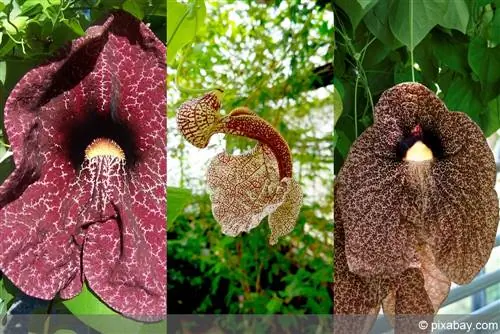
You want a jungle feeling? The pipe flower forms a dense canopy with its overlapping leaves and also bears huge flowers. Since she is happy with little light, she is allowed in the shade.
- Growth height: up to 6 m
- Leaves: numerous, light green, heart-shaped
- Flower: reddish brown, somewhat bizarre funnel shape, very large (depending on the variety)
- Scent: from rather unpleasant to pleasant smelling (depending on the variety)
- Flowering period: June to autumn
- Planting time: Sowing possible indoors all year round
- Location: partial shade
- Soil: humus-rich substrate
- Care: spray regularly, water with rainwater
Note:
The pipe flower is poisonous. Always work with gloves. It is better to avoid this plant if there are small children in the house.
Japanese hops (Humulus japonicus)
Hand-sized leaves lined up closely together. The Japanese hops have one of the densest leaves among climbing plants.
- Growth height: up to 4 m
- Leaves: green, shape resembles grape leaves, 10-15 cm
- Flower: small and simple
- Flowering time: summer
- Planting time: from April
- Location: shady and dry, but moist in the pot
- Soil: normal garden soil
- Care: plenty of water and fertilizer
- Special feature: decorative hop cones
Tip:
If you want to green large areas, plant several plants at the same time. A distance of 60 cm is optimal.
Morning Bindweed (Ipomoea indica)
It bears its first flowers in spring. They bloom early in the morning only to fade later that same day. But don't worry, the blooming fun continues, new flowers are constantly appearing.
- Growth height: 3 m and more
- Leaves: decorative, green, medium-sized
- Flower: funnel-shaped, mostly blue
- Flowering period: July to October
- Planting time: Spring, slight protection from the cold may be necessary
- Location: sun, but also shade, suitable for pot cultivation
- Soil: calcareous, permeable, rather poor
- Care: fertilize moderately
Colorful and fragrant sun lovers
Why not choose the most beautiful climbing plant if you have the right sunny spot? But which climbing plant should you choose if one is more beautiful than the other?
Black-eyed Susan(Thunbergia alata)
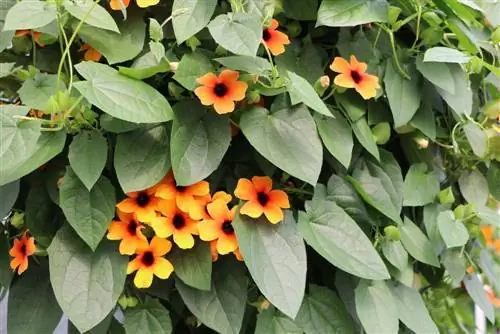
Why is the most famous and popular climbing plant called the black-eyed Susan?
Because in the middle of the flower a large black dot contrasts with the flower color. Like the iris in the human eye.
- Growth height: grows up to 20 cm per week
- Leaves: medium green, gently serrated
- Flower: white and yellow-red shades
- Flowering time: until autumn
- Planting time: pre-culture from March
- Location: warm, sheltered from the wind, full sun
- Soil: loose substrate
- Care: fertilize every two weeks
Tip:
Black-eyed Susan forms strong roots. Give it a large pot or an outdoor space right from the start.
Scented vetch (Lathyrus)
The Mediterranean classics do not grow as tall as other climbing plants, but at around 1.50 m they are ideal for garden fences. The sweet peas also make a beautiful eye-catcher in balcony boxes and pots.
- Growth height: up to 1.5 m
- Leaves: pinnate, up to 6 cm long
- Flowering: numerous butterfly flowers
- Fragrance: intensely fragrant
- Flowering time: midsummer
- Planting time: from April on site outdoors or in a container
- Location: sunny, sheltered
- Soil: nutrient-rich, with a high pH value.
- Care: fertilize heavily, clean out any dead flowers
Tip:
All shades from white to purple can be combined well with each other.
Rose Calyx (Rhodochiton atrosanguineus)
If you love the color red, bring one of the most beautiful red tones into your garden with the rose cup. Rose coat, rose dress or purple bell wine are other names for this delicate plant.
- Growth height: up to 2 m
- Leaves: about 7 cm long, heart-shaped
- Flower: tubular, scarlet, long-lasting
- Flowering time: July to August
- Planting time: pre-culture in spring,
- Location: sunny, warm
- Soil: no special requirements
- Care: water and fertilize abundantly in summer
Note:
Rose calyx is a light germinator, the seeds must not be covered with soil or only lightly covered.
Climbing Snapdragon (Asarina scandens)
The snapdragon is not only available as a small garden plant. With the climbing version, high fences can be easily planted with greenery. The variety of colors is equally impressive.
- Growth height: approx. 1.80 m
- Leaves: heart-shaped, approx. 5 cm tall
- Flower: different colors, tubular, up to 5 cm tall, hairy
- Flowering period: May to October
- Planting time: February to April Pre-culture
- Location: sunny, sheltered from the wind
- Soil: normal garden soil
- Care: water and fertilize regularly
Note:
Climbing snapdragons that grow in containers can be overwintered indoors.
Mandevilla (Dipladenia)
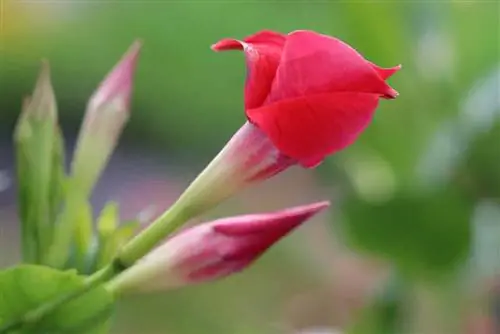
Not all, but some varieties, are good climbers. The flower is somewhat reminiscent of oleander.
- Growth height: up to 5 m, also possible as a hanging plant
- Leaves: shiny, oval
- Flower: 5-10 cm, funnel-shaped, white, pink or red
- Flowering period: May to October
- Planting time: pre-culture, outdoors from June
- Location: sunny, warm, protected from rain, best in pots
- Soil: humus and loose
- Care: keep moist without waterlogging, fertilize a lot
Note:
When you hear Chilean jasmine, Diamanta, Sundaville or Tropidenia, you are also referring to this beautiful climbing plant.
Morning glory (Ipomena)
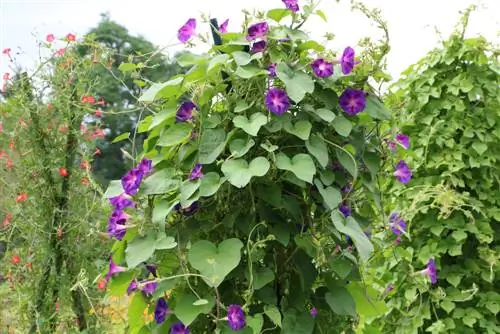
The morning glory has more than 650 species to offer. With proper care, it tirelessly develops new flowers until autumn. It can thrive “almost” anywhere there is a free sunny spot, in the garden between other plants or as a solitary plant in a pot.
- Growth height: 3 m and more
- Leaves: heart-shaped to oblong, green, medium-sized
- Flower: funnel-shaped, up to 12 cm in diameter, pink, violet, etc.
- Flowering period: June to October
- Planting time: Harden off slowly from May
- Location: Sun, also suitable for pots
- Soil: Garden soil with compost
- Care: fertilize monthly with mineral fertilizer
- Special feature: toxic, protective measures required
Tip:
Morning glories like to share a climbing frame with clematis or roses, so you can achieve more fullness. Especially while the other plants are still young and therefore still have little volume.
Delicious tasting additions
Sometimes the beautiful can be combined with the useful, as with the following climbing plants. Not only do they produce abundant green leaves and colorful flowers, their fruits are also delicious.
Hokkaido pumpkin (Cucurbita maxima)
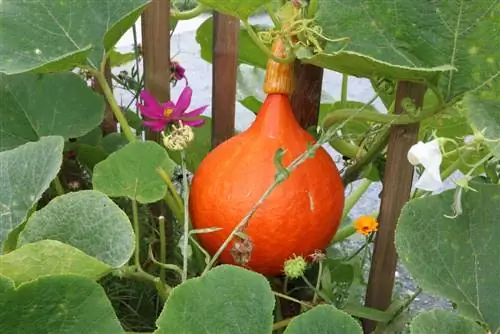
It can crawl on the ground, but also grows quickly when presented with a climbing opportunity. Once started, its large green leaves quickly form a stately wall. In autumn its fruits enrich the menu.
- Growth height: depending on the variety, 3-10 m, multi-branched tendrils
- Leaves: large, deep green
- Flowers: large golden yellow flowers, edible
- Flowering time: from June to November, new flowers constantly
- Planting time: grow in pots around the end of April
- Location: sunny to partially shaded, outdoors or large containers
- Soil: soil richly fertilized with compost, as it is a heavy feeder
- Care: above all, water abundantly
The development of pumpkin fruits is announced by large, orange flowers. Hokkaido pumpkins can also be grown in pots and are therefore also suitable for the balcony.
Note:
All pumpkin varieties are good climbers. If you choose ornamental pumpkins, you should know that most varieties are not suitable for consumption.
Nasturtium (Tropaeolum majus)
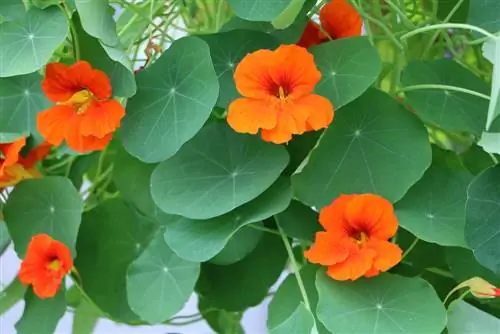
It can be eaten and is he althy, both leaves and flowers. If you add a few to the salad, there will still be plenty left over to cover the planting site.
- Growth height: up to 3 meters
- Leaves: 3-10 cm diameter, light green, almost round and somewhat angular,
- Flower: five sepals, variations in yellow, orange or red,
- Fragrance: only exudes when cut, intensely spicy
- Flowering period: from early May to early October
- Planting time: from the end of May outdoors, from March on the windowsill
- Location: sun, partial shade, open ground and pots
- Soil: nutrient-rich and slightly moist
- Care: Water when dry, no fertilizer necessary
The most impressive thing for the viewer is the color contrast: light green leaves combined with orange flowers.
Did you know
that the green leaves of the nasturtium cannot get wet? The water drops simply roll off it. Looks fun.
Fietan bean (Phaseolus coccineus L.)
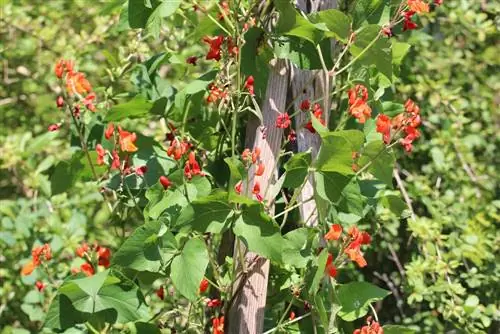
It grows on corn stalks in the garden or in pots on the balcony. Because of the abundant flowers, it initially looks like a purely flowering plant. The delicious bean pods only gradually develop.
- Growth height: 2-3.5 m
- Leaves: 3 egg-shaped, pointed leaves per stem
- Flowers: 6-10 butterfly flowers each arranged in clusters, red, sometimes white
- Flowering period: June to September
- Planting time: Direct sowing in early to mid-May, early cultivation possible from March
- Location: sunny, sheltered from the wind, tolerates partial shade, for open ground and deep containers
- Soil: loose, permeable and moist
- Care: water a lot without waterlogging, fertilize with compost
- Special feature: raw beans are poisonous and may only be consumed when heated.
It also has other names in everyday use: flower bean, runner bean, runner bean, make-up bean or Turkish bean
Tip:
If you just want to be content with the beautiful flowers, then simply clean out the energy-sapping fruits regularly.
Unusual exotics from far away
For everyone who has a lot of space or likes to take unusual paths, the climbing plant family offers a few unusual specimens. Here are two examples:
Exploding cucumber (Cyclanthera brachystachya)
The South American exploding cucumber winds itself up quickly on strings or wires. Their flowers are not very noticeable, but the small cucumbers are even more so. And at some point they suddenly explode. They throw the seeds meters away.
- Growth height: up to 5 m
- Leaves: yellow-green, medium-sized, usually five-lobed
- Flower: small, inconspicuous
- Flowering period: summer, continuous
- Planting time: from May in the open ground or in pots
- Location: warm and sunny
- Soil: nutrient-rich, otherwise undemanding
- Care: water abundantly on dry days
- Special feature: cucumber fruits, 5 cm long, curved and prickly
Tip:
The small cucumbers are popular in Brazil. Maybe they will suit your taste too!?
Pearl Plant (Dalechampia spathulata 'Mathea')
The main attraction of this exotic climbing plant is the two leaves that surround each individual flower. They are bright pink.
- Growth height: up to 5 m
- Leaves: most are green and medium-sized
- Flower: inconspicuous and short-lived, pink leaves are an optical “flower replacement”
- Flowering time: summer
- Planting time: from May in the pot
- Location: sunny and warm, but can also tolerate cooler temperatures
- Soil: no special requirements
- Care: water moderately, fertilize regularly
- Synonym: Flamingo Flower
From a distance, this creeper and liana plant looks as if many pink butterflies have settled down.
Collecting seeds for the next generation
Sit back and enjoy your annual climbing plants. But this fall, don’t forget to think about the next generation. With the first frosts the splendor is over. If you harvest the ripe seeds in time, you'll have new climbing plants to start next spring - free of charge.
Note:
If your climbing plants were grown from hybrid seeds, the seeds formed are unsuitable for propagation.

